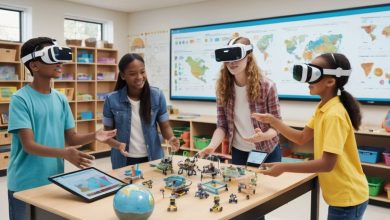Interactive Educational Resources to Enhance E-Learning
In a world where online courses have become the norm, keeping learners engaged requires more than static text and pre-recorded lectures. Interactive educational resources transform passive consumption into active participation, boosting comprehension and retention. In this article, you’ll discover the most effective tools—gamified platforms, virtual labs, AR/VR experiences, collaborative boards, and interactive assessments—and learn how to integrate them into your e-learning environment to elevate engagement and learning outcomes.
Why Interactivity Matters in E-Learning
Interactivity is not just a nice-to-have; it’s the cornerstone of successful e-learning. When learners actively participate, they process information more deeply and stay motivated throughout the course. Key benefits include:
-
Immediate Feedback: Interactive quizzes and simulations correct misconceptions on the spot, preventing errors from becoming fixed.
-
Multisensory Engagement: Combining visuals, text, and hands-on tasks appeals to visual, auditory, and kinesthetic learners alike.
-
Social Interaction: Collaborative tools foster peer-to-peer learning, mimicking in-person discussions and group projects.
-
Personalization: Adaptive content adjusts difficulty based on individual performance, ensuring learners neither feel bored nor overwhelmed.
By embedding interactive elements, you encourage learners to explore, experiment, and apply knowledge—leading to deeper understanding and better long-term retention.
Categories of Interactive E-Learning Resources
Gamified Learning Platforms
-
Kahoot!: Live-hosted quizzes with real-time leaderboards turn review sessions into friendly competitions. Educators create multiple-choice questions; students participate via a code, keeping energy high and encouraging peer engagement.
-
Quizizz: Offers self-paced, game-like quizzes. Learners receive immediate feedback on each answer and can track their progress. The asynchronous mode lets students complete quizzes on their schedule, making it ideal for flipped classrooms.
Virtual Labs & Simulations
-
PhET Interactive Simulations: A free collection of browser-based science and math simulations. From titrations to circuit experiments, students manipulate variables and observe outcomes—mirroring real lab work without safety risks or equipment costs.
-
Labster: 3D virtual labs for biology, chemistry, and physics. Students complete realistic experiments—dissecting cells, running chemical reactions—while AI coaches guide them through each step. Labster’s analytics report on student decisions, helping instructors identify misconceptions.
Augmented & Virtual Reality (AR/VR) Tools
-
Google Expeditions (AR): Delivers immersive virtual field trips to historical sites, ecosystems, and more. Students use their devices to explore layered visualizations—such as ancient ruins overlaid on their classroom floor—offering context that text alone cannot provide.
-
zSpace: Combines VR and AR to create interactive STEM experiences. Learners can manipulate 3D models of organs, molecules, or engineering prototypes, examining structures from any angle. These hands-on experiences deepen spatial understanding and spark curiosity.
Collaborative Whiteboards & Boards
-
Padlet: A virtual bulletin board where students post multimedia content—text, images, videos—and comment on peers’ contributions. Perfect for brainstorming, mind mapping, and sharing research findings in real time.
-
Miro: A digital canvas for collaborative mind maps, flowcharts, and Kanban boards. Multiple participants can edit simultaneously, making it ideal for project planning, group problem-solving, and visual brainstorming.
Adaptive Content Platforms
-
Khan Academy: Provides interactive practice exercises in math, science, and more. Each student receives personalized skill recommendations, ensuring they focus on concepts where they need the most help. Real-time hints and video tutorials support mastery.
-
DreamBox Learning: An AI-driven math platform for K–8 students. Lessons adapt dynamically: if a learner struggles, DreamBox offers scaffolded hints; if they breeze through, it introduces more challenging problems. The instructional flow mimics one-on-one tutoring.
Interactive Assessment Tools
-
Edpuzzle: Enables instructors to embed questions—multiple choice, open-ended—directly into video lessons. Learners must answer before proceeding, ensuring active engagement. Instructors receive detailed reports on responses, highlighting areas needing review.
-
Socrative: Offers instant polling, quizzes, and exit tickets. During live sessions, teachers launch polls; students respond on any device. Immediate visual results—bar charts, heat maps—help instructors gauge comprehension and adjust instruction on the fly.
AI-Powered Tutoring & Chatbots
-
Quizlet Learn: Uses AI to generate tailored flashcard decks based on a learner’s performance and confidence levels. As learners answer, Quizlet adjusts review intervals to reinforce long-term memory.
-
Woebot for Education: A chatbot that guides students through study sessions, offering reminders, motivational prompts, and on-demand support for basic questions. By providing immediate assistance, it reduces frustration and keeps learners on track.
Comparative Analysis: Static vs. Interactive Resources
| Feature | Static Resources | Interactive Resources |
|---|---|---|
| Engagement | Passive reading or video-watching | Active participation via quizzes, simulations, and collaborative tasks |
| Feedback | Delayed feedback (assignment grading, discussion boards) | Immediate feedback (auto-graded quizzes, in-sim responses, live polls) |
| Adaptivity | One-size-fits-all content | Personalized pathways through adaptive algorithms and branching scenarios |
| Collaboration | Limited to forums or email correspondence | Real-time collaborative boards, shared simulations, group gamification sessions |
| Retention | Often lower—reliant on repetition | Higher—engages multiple senses and interactive problem-solving |
| Implementation Effort | Simple to set up (upload PDF, record video) | Requires integration of specialized platforms and training for instructors |
Pros & Cons
-
Static Resources
-
Pros:
-
Easy to create and upload.
-
Low bandwidth requirements.
-
-
Cons:
-
Less engaging; learners may lose focus.
-
No immediate feedback; misconceptions linger.
-
-
-
Interactive Resources
-
Pros:
-
Boosts engagement and active learning.
-
Provides instant feedback and data-driven insights.
-
Fosters collaboration and peer learning.
-
-
Cons:
-
Higher setup complexity; instructors need training.
-
May require reliable internet and investment in premium features.
-
-
Integrating Interactive Resources into E-Learning
-
Assess Learning Objectives & Audience Needs
-
Identify Core Competencies: Determine which skills require active engagement—e.g., lab techniques, data analysis, collaboration.
-
Evaluate Learner Profiles: Survey students’ device access, internet reliability, and digital literacy to choose appropriate interactive tools.
-
-
Select & Pilot Core Interactive Tools
-
Choose a Simulation: Implement PhET for a single unit—such as electricity and magnetism—replacing static diagrams.
-
Incorporate Gamification: Create a Kahoot! quiz covering key terminology and launch it during a live session to gauge understanding.
-
Launch Collaborative Board: Set up a Padlet for students to brainstorm and share project ideas, fostering peer feedback.
-
-
Design Lesson Flows with Interactivity
-
Pre-Work: Assign a brief video or reading to introduce concepts.
-
Synchronous Session: Use video conferencing (e.g., Zoom) to discuss pre-work, then break into groups for Labster simulations or PhET experiments in breakout rooms.
-
Interactive Check: Embed an Edpuzzle video that pauses for quiz questions, ensuring learners engage with essential points.
-
Group Collaboration: Facilitate a Miro mind map session where learners co-create study guides or project outlines.
-
-
Train Educators & Support Staff
-
Host Live Workshops: Provide a two-hour session demonstrating:
-
Embedding PhET simulations into your LMS.
-
Creating and running Kahoot! quizzes and analyzing results.
-
Managing Padlet boards and Miro canvases for group work.
-
-
Offer Asynchronous Tutorials: Produce short “how-to” videos showing step-by-step setup and best practices.
-
Establish Help Channels: Create a dedicated forum or chat group where instructors can ask technical questions and share tips.
-
-
Collect Data & Refine
-
Monitor Platform Analytics:
-
Track PhET usage—completion rates, time spent on tasks.
-
Review Kahoot! engagement—response accuracy, average response times.
-
-
Gather Learner Feedback: Distribute mid-unit surveys asking which interactive elements were most helpful.
-
Adjust Pacing & Tools: If a simulation shows high engagement but low completion, allocate more time or provide additional scaffolding before the exercise.
-
-
Scale Across Courses & Continual Improvement
-
Expand Implementation: Once the pilot demonstrates success, introduce interactive tools to additional subjects—math, history, or language arts.
-
Conduct Monthly Review Sessions:
-
Introduce new resources (e.g., DreamBox for adaptive math).
-
Retire underutilized platforms and reallocate budgets accordingly.
-
Offer advanced training for faculty to deepen interactive content design skills.
-
-
FAQs (Rich-Result Ready)
What free platforms offer quality virtual labs for science education?
PhET Interactive Simulations provides free, browser-based virtual labs in physics, chemistry, and biology, allowing users to manipulate variables and observe results. CK-12 also includes embedded virtual labs within its FlexBooks for K–12 science subjects.
How can I create effective gamified quizzes without coding experience?
Answer:
Platforms like Kahoot! and Quizizz offer user-friendly interfaces where you can drag and drop multiple-choice questions, upload images, and set time limits—all without coding. Simply sign up, create a “quiz,” and launch it live or assign it asynchronously.
Are AR/VR tools feasible for large-scale online courses?
While hardware-based AR/VR solutions (e.g., zSpace) require headsets, many experiences run on standard devices. Web-based VR (e.g., WebXR) works on most modern browsers. Institutions can provide shared VR headsets in labs or lend equipment to learners, scaling immersive experiences more broadly.
How do I ensure accessibility when using interactive resources?
Choose platforms with built-in accessibility features: closed captions for video (e.g., Zoom’s auto-caption), screen reader compatibility (e.g., Canvas supports ARIA labels), and keyboard navigation. Provide alternative text for images and transcripts for audio content. Prioritize tools that comply with WCAG standards.
What’s the best way to integrate interactive tools into an existing LMS?
Most interactive tools support LTI (Learning Tools Interoperability) integration. In your LMS (Canvas, Moodle):
-
Navigate to External Tools or Integrations settings.
-
Add the tool’s LTI URL, key, and secret provided by the vendor (e.g., Nearpod, Kahoot!).
-
Configure launch settings—grade passback, open in new window—to seamlessly embed simulations or quizzes within course modules.
Conclusion
Interactive educational resources—spanning gamified platforms, virtual labs, AR/VR experiences, collaborative boards, and interactive assessments—transform e-learning from passive screen time into active, engaging learning experiences. By following the step-by-step integration tutorial—assessing objectives, piloting core tools, training educators, and continually refining based on data—you can create dynamic online courses that rival face-to-face instruction. Tracking metrics such as engagement rates, learning gains, and satisfaction ensures your interactive strategy delivers tangible results. Equip your e-learning environment with these resources and watch engagement soar, retention improve, and learners thrive in any digital setting.
Published on: 4 de June de 2025








